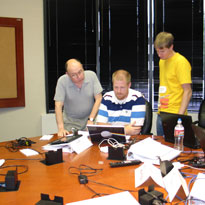Modern Telecommunications Overview
- Course:Modern Telecommunications Overview
- Course ID:TELECOM1 Duration:2-5 days Where: Your Office (7+ Persons)
- Download Course Description (PDF)
Available as a private, customized course for your group at your offices or ours and in some cases as a WebLive(TM) class.
Course Outline
Part 1: Telecommunications overview, major telecom systems, protocols and standards
- What is telecom?
- Overview diagram and explanation
- Basic components of any telecom system
- How they relate to end-user needs
- Goals of telecom and how pieces fit together at highest level
- Overview diagram and explanation
- How telecom technologies work: the basics (partial list)
- Wired and wireless systems
- The electromagnetic spectrum
- Analog vs digital
- Conversion of analog to digital
- Connection-oriented vs connectionless
- Dedicated vs. switched
- Synchronous vs asynchronous
- Protocols
- Packets
- Bandwidth
- Carriers and modulation
- MPEG, JPEG, etc.
- BRI, PRI
- Major telecom systems (partial list)
- Wired systems: Copper/twisted pair, coax, optical fiber
- RF/SATCOM: Land Mobile Radio (LMR), satellite
- Cellular: Evolution of 2G to 3G, 4G LTE, and 5G
- Other wireless: WiFi, CDMA2000, WiMAX
- Optical: SONET/SDH, DWDM
- Ethernet
- IP
- MPLS/VPN
- ISDN
- Free space optics
- Radio/TV
- Protocols and standards
- Purpose of and need for protocols and standards
- OSI stack and how it relates to various systems and technologies
- Understanding telecom in terms of layers
- How layers relate to technologies
- OSI stack and end-end telecommunications
- Standards bodies and some typical standards
- Internet Protocol (IP) and Transmission Control Protocol (TCP)
- What they are
- How they work
- How modern networks utilize them
- How they are implemented across technologies and systems
- Quality of Service (QoS) and IP networks
- IP and common applications
- The Internet and how it works
- Overview
- Addressing
- Infrastructure
- End users and access
- Regulation and future of the Internet
- IP Multimedia System (IMS)
- What it is, goals
- How it is envisioned to work
- Relationship with other technologies
- Fixed/mobile convergence
Part 2: In-depth discussion of select technologies, putting together whole systems, the Cloud, major evolving trends, how to buy telecom
- Telephony and VoIP
- How it works
- Supporting protocols
- H.323 and SIP
- IP PBX and other equipment
- Endpoint (access) technologies
- Equipment (hardware/software)
- Service delivery points (SDPs)
- Purchase and pricing
- Transport (link) technologies
- Equipment
- Modulation techniques
- SONET/MPLS/VPNs
- Performance/capabilities
- Limitations to performance (speed, error rates, Shannon’s law, etc.)
- Impairments and their effect (noise, jitter, etc.)
- Purchase and pricing
- Putting it all together
- Building an end-end system
- Components
- How they work together
- End-end performance specs
- Examples of end-end systems
- Building an end-end system
- The Cloud and modern usage of telecom
- What the Cloud is
- Brief history
- What it can do and what it is expected to do in future
- How Cloud relates to telecom
- Evolving technologies and trends
- Future trends in telecom equipment, services, usage, prices, and regulation
- Software Defined Networks (SDN)
- Virtualization: Communications side, equipment side
- Network Functions Virtualization (NFV)
- Machine-to-Machine (M2M) communications
- How to buy telecom equipment and services
- Turnkey services vs. do-it-yourself
- Pricing
- Design and implementation considerations
- Course wrap-up
Course in a Nutshell
This course will help you acquire a solid, high-level understanding of modern telecom systems, the technologies behind them, their performance goals and limitations, and the purchase/pricing and assembly of such systems. Covered are the major wireline and wireless technologies and trends including Ethernet, SONET, ISDN, IP and the Internet, IMS, MPLS, VPN, VoIP, Land Mobile Radio (LMR), Satellite, WiFi, 2G/3G/4G wireless, LTE, Cloud Computing, Software Defined Networks (SDN), Network Functions Virtualization (NFV), Machine-to-Machine Communications, and more.
Customize It!
We can tailor this course to your team’s needs by adjusting its ‘tech level’ up or down and by including or excluding topics. Depending on the desired coverage and technical depth, the course can be taught in two to five days.
Learn How To
- Define/describe the important telecommunications terms/concepts
- Provide a high-level description of the major wireline and wireless technologies and trends.
- Characterize the capabilities and limitations of major telecommunications equipment and systems
- Conceptualize how to assemble telecommunications systems for various objectives
- Describe how telecommunications services are regulated and priced
Aimed At
Corporate and government decision-makers and professionals involved in the acquisition of equipment or services, technical consultation, liaison, or support, and others whose work requires a broad foundation in telecommunications.
Prerequisites
Those wishing to take this course should have some prior on-the-job exposure to telecom or information technologies.

